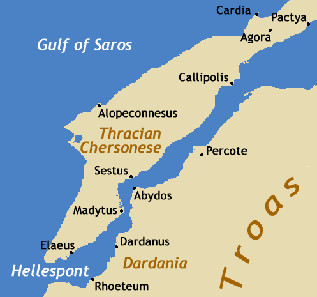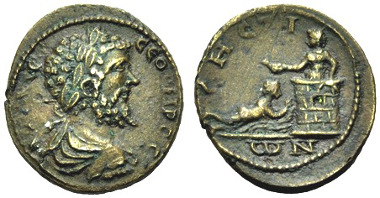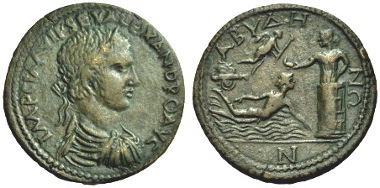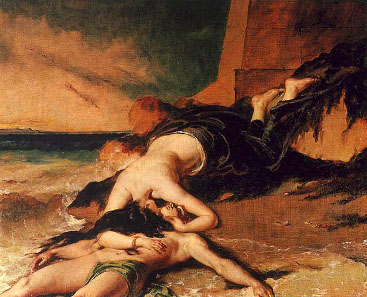by Claire Franklin
Ancient coins, more than any other surviving artefacts, can take us back into the life and thought of the ancient world. They reflect the concerns and interests of the city states at the time they were produced. For the city states (poleis) of Asia Minor which had been incorporated into the Roman empire, coinage was a means through which they could still reflect and glorify their own history; on the obverse face, a portrait of the current emperor of Rome, but on the reverse, a link back to their individual pasts and heritage.
Sestos and Abydos lie on opposing sides of the Hellespont strait. Dorieo21 / http://creativecommons.org/licenses/by-sa/3.0/deed.en
Many coins struck by Roman provinces depict scenes of gods and heroes from mythology which had a particular local significance, and Abydos and Sestos, two cities lying on opposing sides of the Hellespont strait separating Troas from the Thracian Chersonese (and thus forming the divide between Asia and Europe) were no different. Indeed, they could draw on a particularly poignant local myth, one which had already been much developed in literature and was destined to have a long afterlife.
Greek coins minted under Roman Rule, Thrace, Sestos. Septimius Severus, 193-217. Bronze. Compare BMC 200,18 (Caracalla, with the same reverse). See F. Sternberg, auction from 28-29.11.1975, 147 (this coin). Nearly extremely fine. From F. Sternberg, Auction in Zürich from 28th-29th 11.1975, 47.
In the second century after Christ both Abydos and Sestos struck coinage illustrating a scene from the myth of Hero and Leander (the coin of Sestos is a unique example). Hero was a priestess of Aphrodite at Sestos on the European side of the Hellespont. At a feast of Aphrodite she met the beautiful youth Leander of Abydos, which was on the Asian shore, and the two became lovers.
The next part of the tale can be seen from the coins: Leander swam the Hellespont every night (luckily the fauces abydenae, as Virgil calls the straits, were at their narrowest here – seven stadia – but this was still some 1344 metres or 0.8 miles). The coins of both Abydos and Sestos show how Hero stands on a high tower overlooking the sea, holding an oil lamp in the direction of Leander, who swims towards her.
Greek coins minted under Roman Rule. Troas, Abydos. Severus Alexander, 222-235. Large Bronze. SNG von Aulock 7543 (this coin). Nearly extremely fine. from the collection of H. von Aulock and Bank Leu AG, Auction 18 in Zürich (1977), 180.
On the coin of Severus Alexander, a small helpful Eros is additionally portrayed, lighting the way and recalling Leander’s words in the Heroides of Ovid:
est aliud lumen, multo milii certius istis, non errat tenebris quo duce noster amor (Heroides, xviii 155-156);
“There is another light, far surer for me than those, and when it leads me through the dark my love leaves not its course …”
If we are to believe the ancient myths, Leander repeated this feat every night, swimming back home at dawn – according to the image of the coin of Severus Alexander he left his clothes in a heap on the Asian shore of the Hellespont, though Ovid writes of Hero (on the European side):
quid referam, quotiens dem vestibus oscula, quas tu Hellespontiaca ponis iturus aqua (Heroides, xix 31-32)
“Why tell how many times I kiss the garments you lay aside when making ready to stem the waters of the Hellespont?”
Our two coins depict the high point of Leander’s affair with Hero, as he heroically negotiates the fierce waters. But ancient viewers of the coins (as well as ancient readers of Ovid’s Heroides) already knew that the story had a tragic ending; one stormy night, the wind blew out the lamp, and Leander, deprived of its guidance, was lost in the tempestuous seas.
William Etty, Hero and Leander, 1828. Source: Wikicommons.
When Hero found his dead body she threw herself from her tower to be with her dead lover. In this respect it is a curiously ambivalent image, a tale full of personal tragedy and the private love of two individuals from different states (which were in different provinces of the Roman Empire), as sung by a poet whose erotic poetry had earned him disfavour with an earlier emperor. It contrasts sharply with the normal, official portrait of the emperor surrounded by his titles on the obverses of the two coins. Yet it must have been a tale which struck a chord with the citizens of Abydos and Sestos (or their moneyers). It was most likely so intertwined with the image of the states that it seemed the obvious choice of symbolic image where other states portrayed particular cult statues, buildings or their own foundation myths.
In retrospect, it has also been an enduring image – the tale of Hero and Leander has been reworked by Marlowe, Schiller, Grillparzer and Byron: it has formed the basis of tragedies and operas as well as providing a theme for paintings. In the next auction sale to be held by Münzen und Medaillen GmbH on June 4th, 2014, in Stuttgart, collectors will have the chance to bid on these two different – ancient – depictions of an enduring love story.
Both coins are being offered in the Auction 40 of Münzen & Medaillen GmbH.
You can read an auction preview here.









